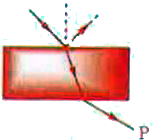State Brewster.s law.
Step-by-Step Text Solution:
1. Understanding Brewster's Law: Brewster's Law describes the relationship between the angle of incidence and the polarization of light. It states that when unpolarized light strikes a transparent surface, there is a specific angle at which the reflected light is completely polarized.
2. Defining the Polarizing Angle: This specific angle of incidence is known as the Brewster's angle (denoted as IP). At this angle, the reflected light is completely plane polarized.
3. Mathematical Expression: Brewster's Law can be mathematically expressed as:
μ=tan(IP)
where μ is the refractive index of the medium and IP is the Brewster's angle.
4. Conclusion: Therefore, Brewster's Law states that the tangent of the polarizing angle for a given medium is numerically equal to the refractive index of that medium.
Final Statement:
Brewster's Law states that the angle of incidence at which unpolarized light is reflected as completely plane polarized light is called the Brewster's angle (IP), and it is given by the relationship μ=tan(IP), where μ is the refractive index of the medium.
---
μ=tan(IP)
where μ is the refractive index of the medium and IP is the Brewster's angle.
Brewster's Law states that the angle of incidence at which unpolarized light is reflected as completely plane polarized light is called the Brewster's angle (IP), and it is given by the relationship μ=tan(IP), where μ is the refractive index of the medium.
Similar Questions
State Charles.s law
View SolutionConsider is light beam incident from air to a glass slab at
Brewster.s angle as shown in Fig.

A Polaroid is placed in the path of the emergent ray at point P and rotated about an axis passing through the centre and perpendicular to the plane of the polaroid.
View Solution
Knowledge Check
From Brewster's law, except for polished metallic surfaces, the polarising angle
Adepends on wavelength and si different for different coloursBindependent of wavelength and is different for different coloursCindependent of wavelength and is same for different coloursDdepends on wavelength and is same for different coloursAn upolarized light beam is incident on a surface at an angle of incidence equal to Brewster's angle. Then,
Athe reflected and the refracted beam are both partially polarizedBthe reflected beam is partially polarized and the refracted beam is completely polarized and are at right angles to each otherCthe reflected beam is completely polarized and the refracted beam is partially polarized and are at right angles to each otherDboth the reflected and the refracted beams are completely polarized and are at right angles to each other.
State Newton.s law of gravitation. Distinguish between g and G.
View SolutionState Moseley.s law.
View SolutionSuppose θ is the polarizing angle for a transparent medium and the speed of light in that medium is v. (Then according to Brewster law )
View SolutionWhen light is polarised by reflection from a transparent surface.
a) reflection and refracted rays are mutually perpendicular
b) both reflected and refracted rays are plane polarised
c) refraction ray is partially polarised
d) the R.I., of transparent surface is equal to tangent of Brewster.s angle
View SolutionState the power law of exponents
View SolutionState Newton's law of gravitation.
View Solution